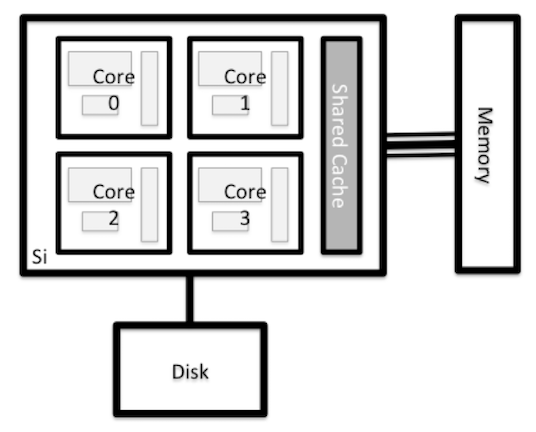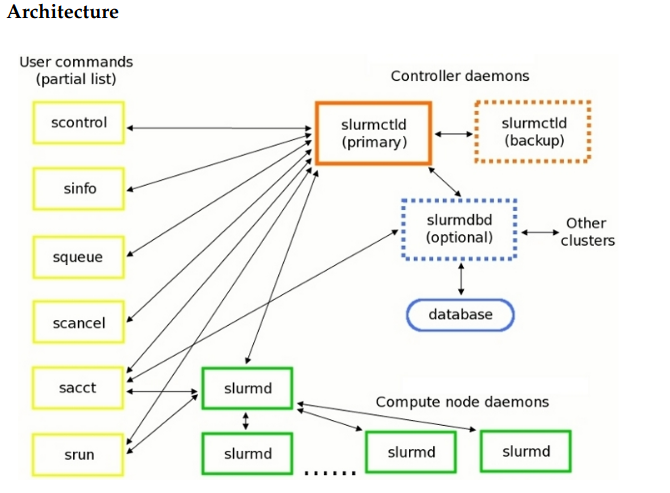Table of Contents
Install Slurm
What is a High-Performance Computer?
A high-performance computer (HPC system) is a tool used by computational scientists and engineers to tackle problems that require more computing resources or time than they can obtain on the personal computers available to them.
What is a HPC (High-Performance Computer)?
* Computers connected by some type of network (ethernet, infiniband, etc.). * These computers is often referred to as a node. * Several different types of nodes, specialized for different purposes. * Head (front-end or/and login): where you login to interact with the HPC system. * Compute nodes (CPU, GPU) are where the real computing is done. Access to these resources is controlled by a scheduler or batch system.
HPC architecture
Nodes
Parts of HPC system
- Servers:
- Server Master: master1, [master2 (Backup)]
- Server login
- Server accounting: mysql server
- Nodes: Physical or/and VM
- Storage: (CEPH, Lustre, etc.)
- Scheduler: Slurm, torquePBS, etc.
- Applications: Monitoring, software control, etc.
- Users database: OpenLDAP, AD, etc.
Storage and file systems
- Lustre: is a parallel distributed file system.
- Spectrum Scale: is a scalable high-performance data management solution.
- BeeGFS: was developed for I/O-intensive HPC applications.
- OrangeFS: is a parallel distributed file system that runs completely in user space.
- Ceph: that offers file-, block- and object-based data storingon a single distributed cluster.
- GlusterFS: has a client-server model but does not need a dedicatedmetadata server.
Scheduler
In order to share these large systems among many users, it is common to allocate subsets of the compute nodes to tasks (or jobs), based on requests from users. These jobs may take a long time to complete, so they come and go in time. To manage the sharing of the compute nodes among all of the jobs, HPC systems use a batch system or scheduler.
The batch system usually has commands for submitting jobs, inquiring about their status, and modifying them. The HPC center defines the priorities of different jobs for execution on the compute nodes, while ensuring that the compute nodes are not overloaded.
A typical HPC workflow could look something like this:
- Transfer input datasets to the HPC system (via the login nodes)
- Create a job submission script to perform your computation (on the login nodes)
- Submit your job submission script to the scheduler (on the login nodes)
- Scheduler runs your computation (on the compute nodes)
- Analyze results from your computation (on the login or nodes, or transfer data for analysis elsewhere)
Slurm:
- Is an open source, and highly scalable cluster management and job scheduling system.
- Requires no kernel modifications for its operation
- Is relatively self-contained.
Slurm has three key functions
- It allocates exclusive and/or non-exclusive access to resources (nodes) to users for some duration of time so they can perform work.
- It provides a framework for starting, executing, and monitoring work on the set of allocated nodes.
- It arbitrates contention for resources by managing a queue of pending work.
Slurm architecture
Commands:
- scontrol: is the administrative tool used to view and/or modify Slurm state.
- sinfo: reports the state of partitions and nodes managed by Slurm.
- squeue: reports the state of jobs or job steps.
- scancel: to cancel a pending or running job or job step.
- sacct: is used to report job or job step accounting information about jobs.
- srun: to submit a job for execution or initiate job steps in real time.
Applications
- Lifecycle management tool: Foreman or PXE server [PXE-DNS-DHCP-TFTP]
- Monitoring services: Nagios, Icinga, etc.
- Monitoring resources (menory, CPU load, etc): gaglia
- SSH server: openssh
- Central control configurations server: Puppet, ansible,
- manage (scientific) software: Easybuild
- Environment Module System: LMOD
- Central users database: OpenLDAP, Active Directory, etc.====
Slurm Installation
- System operation: CentOS 7 or 8
- Define name of every server (hostname): master, node01.. nodeN
- Install database server (MariaDB)
- Create global users (munge user). Slurm and Munge require consistent UID and GID across every node in the cluster.
- Install Munge
- Install Slurm
Create the global user and group for Munge
For all the nodes before you install Slurm or Munge, you need create user and group using seem UID and GID:
export MUNGEUSER=991 groupadd -g $MUNGEUSER munge useradd -m -c "MUNGE Uid 'N' Gid Emporium" -d /var/lib/munge -u $MUNGEUSER -g munge -s /sbin/nologin munge
export SLURMUSER=992 groupadd -g $SLURMUSER slurm useradd -m -c "SLURM workload manager" -d /var/lib/slurm -u $SLURMUSER -g slurm -s /bin/bash slurm
Install Slurm dependencies
In every node we need install a few dependencies:
yum install openssl openssl-devel pam-devel numactl numactl-devel hwloc hwloc-devel lua lua-devel readline-devel rrdtool-devel ncurses-devel man2html libibmad libibumad perl-ExtUtils-MakeMaker gcc -y
Install Munge
In every node we need install that:
We need to get the latest EPEL repository:
yum install epel-release yum update
For CentOS 8, we need edit file /etc/yum.repos.d/CentOS-PowerTools.repo, and enable repository
Change:
enable=0 by enable=1
- Update database repository:
yum update
After that, we can install Munge
yum install munge munge-libs munge-devel -y
In the server master, we need create Munge key and copy that to all another server
yum install rng-tools -y rngd -r /dev/urandom
Creating Munge key
/usr/sbin/create-munge-key -r dd if=/dev/urandom bs=1 count=1024 > /etc/munge/munge.key chown munge: /etc/munge/munge.key chmod 400 /etc/munge/munge.key
Copying Munge key to another server
scp /etc/munge/munge.key root@node01:/etc/munge scp /etc/munge/munge.key root@node02:/etc/munge . . . scp /etc/munge/munge.key root@nodeN:/etc/munge
In every node we need correct the permissions as well as enable and start the Munge service.
chown -R munge: /etc/munge/ /var/log/munge/ chmod 0700 /etc/munge/ /var/log/munge/
systemctl enable munge systemctl start munge
To test Munge, we can try to access another node with Munge from our server node.
munge -n munge -n | unmunge munge -n | ssh node01.cluster.test unmunge remunge
Create Slurm rpm packages
At the server, download the last version of Slurm. At this moment the last version es 19.05.5
cd /tmp wget https://download.schedmd.com/slurm/slurm-19.05.5.tar.bz2 yum install rpm-build rpmbuild -ta slurm-19.05.5.tar.bz2
Copying the Slurm rpm files for installation from the master to the other servers o to a shared folder.
cd ~/rpmbuild/RPMS/x86_64 cp slurm*.rpm /fns/shared_folder
Install Slurm in the Master, compute, and Login nodes:
The slurm-torque package could perhaps be omitted, but it does contain a useful /usr/bin/mpiexec wrapper script.
Before install Slurm, we need disable selinux
nano /etc/selinux/config
change SELINUX=enforcing to SELINUX=disables
cd ~/rpmbuild/RPMS/x86_64 export VER=19.05.5-1 yum install slurm-$VER*rpm slurm-devel-$VER*rpm slurm-perlapi-$VER*rpm slurm-torque-$VER*rpm slurm-example-configs-$VER*rpm
Explicitly enable the service in the master
systemctl enable slurmctld
Only if the database service will run on the Master node: Install the database service RPM:
cd ~/rpmbuild/RPMS/x86_64 export VER=19.05.5-1 yum install slurm-slurmdbd-$VER*rpm
If you have a server for database, install in this server:
export VER=19.05.5-1 yum install slurm-$VER*rpm slurm-devel-$VER*rpm slurm-slurmdbd-$VER*rpm
Explicitly enable the service:
systemctl enable slurmdbd
We need to make sure that the server has all the right configurations and files.
mkdir /var/spool/slurmctld chown slurm: /var/spool/slurmctld chmod 755 /var/spool/slurmctld touch /var/log/slurmctld.log chown slurm: /var/log/slurmctld.log touch /var/log/slurm_jobacct.log /var/log/slurm_jobcomp.log chown slurm: /var/log/slurm_jobacct.log /var/log/slurm_jobcomp.log
Compute nodes
On Compute nodes you may additionally install the slurm-slurmd and slurm-pam_slurm RPM package to prevent rogue users from logging in:
export VER=19.05.5-1 yum install slurm-slurmd slurm-pam-$VER*rpm_slurm-$VER*rpm systemctl enable slurmd
We need to make sure that all the compute nodes have the right configurations and files.
mkdir /var/spool/slurmd chown slurm: /var/spool/slurmd chmod 755 /var/spool/slurmd touch /var/log/slurmd.log chown slurm: /var/log/slurmd.log
Slurm configuration
Slurm provides an example file located at /etc/slurm/slurm.conf.example. You can copy this file to /etc/slurm/slurm.conf
cp /etc/slurm/slurm.conf.example /etc/slurm/slurm.conf
It also have a web-based configuration tool which can be used to build a simple configuration file, which can then be manually edited for more complex configurations.
After that we need to edit /etc/slurm/slurm.conf and make some modifications. Its
vi /etc/slurm/slurm.conf
It is important to change the parameters: ClusterName and ControlMachine.
ClusterName=vlir-test ControlMachine=10.10.2.242 SlurmUser=slurm SlurmctldPort=6817 SlurmdPort=6818 AuthType=auth/munge StateSaveLocation=/var/spool/slurm/ctld SlurmdSpoolDir=/var/spool/slurm/d SwitchType=switch/none MpiDefault=none SlurmctldPidFile=/var/run/slurmctld.pid SlurmdPidFile=/var/run/slurmd.pid ProctrackType=proctrack/pgid ReturnToService=0
If the /var/spool directory does not exist, you need to create it.
mkdir /var/spool/slurm chown slurm.slurm -R /var/spool/slurm
Slurm logging
The Slurm logfile directory is undefined in the RPMs since you have to define it in slurm.conf. See SlurmdLogFile and SlurmctldLogFile in the slurm.conf page, and LogFile in the slurmdbd.conf page.
Check your logging configuration with:
grep -i logfile /etc/slurm/slurm.conf
SlurmctldLogFile=/var/log/slurm/slurmctld.log SlurmdLogFile=/var/log/slurm/slurmd.log
scontrol show config | grep -i logfile
SlurmctldLogFile = /var/log/slurm/slurmctld.log SlurmdLogFile = /var/log/slurm/slurmd.log SlurmSchedLogFile = /var/log/slurm/slurmsched.log
If log files are configured, you have to create the log file directory manually:
mkdir /var/log/slurm chown slurm.slurm /var/log/slurm
Study the configuration information in the Quick Start Administrator_Guide.
Home Users
For the users folder, you can use the server's local disk or mount the remote storage. For this reason it is recommended to create a folder to put the information of the users. In this example we created a folder /home/CLUSTER and here we create the folder for every users.
mkdir /home/CLUSTER
Creating users
For the users you can crate every user manually o you can user an external user database how Active Directory, OpenLDAP or MySQL, etc. For this example we going to create the users manually in every server.




